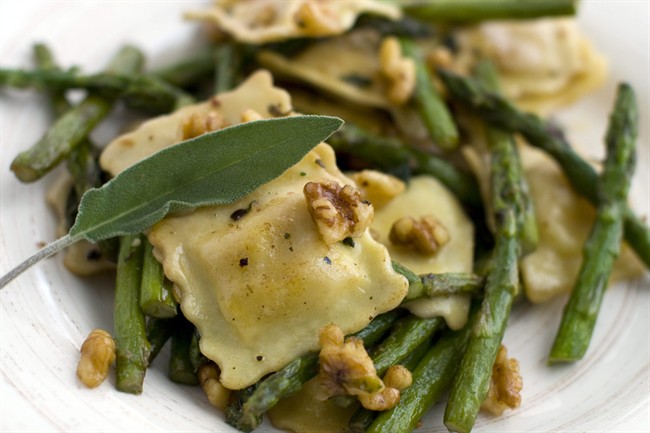How to use ghee and a recipe for ravioli with fried sage and asparagus
Advertisement
Read this article for free:
or
Already have an account? Log in here »
To continue reading, please subscribe:
Monthly Digital Subscription
$0 for the first 4 weeks*
- Enjoy unlimited reading on winnipegfreepress.com
- Read the E-Edition, our digital replica newspaper
- Access News Break, our award-winning app
- Play interactive puzzles
*No charge for 4 weeks then price increases to the regular rate of $19.00 plus GST every four weeks. Offer available to new and qualified returning subscribers only. Cancel any time.
Monthly Digital Subscription
$4.75/week*
- Enjoy unlimited reading on winnipegfreepress.com
- Read the E-Edition, our digital replica newspaper
- Access News Break, our award-winning app
- Play interactive puzzles
*Billed as $19 plus GST every four weeks. Cancel any time.
To continue reading, please subscribe:
Add Free Press access to your Brandon Sun subscription for only an additional
$1 for the first 4 weeks*
*Your next subscription payment will increase by $1.00 and you will be charged $16.99 plus GST for four weeks. After four weeks, your payment will increase to $23.99 plus GST every four weeks.
Read unlimited articles for free today:
or
Already have an account? Log in here »
Hey there, time traveller!
This article was published 10/01/2012 (5056 days ago), so information in it may no longer be current.
Why not just use butter?
Fair question, especially since ghee is going to be more trouble to find (it’s hidden in your grocer’s international or natural foods aisles) and you’ll pay way more for it.
Despite that, it’s an easy answer — because ghee is a rich indulgence that is so totally worth the effort and expense.

Ghee is a form of clarified butter. Which means it is butter that was heated until the milk solids separated from the liquid. Then it was heated some more, until the liquid evaporated and the solids began to brown.
The result is a thick yellow-brown paste with a nutty and intensely — Are you ready? — buttery flavour. But it’s true. This is butter on steroids.
And yes, it’s easy to make your own. And no, most of us won’t.
Ghee originated in India, where the heat spoils conventional butter. Clarifying it prolongs its unrefrigerated life from a couple weeks to many months.
When to use it? Given the price, not every day. But this is the stuff to reach for when you want to be seriously slapped around by buttery goodness.
As in making the very best popcorn. Ever. Here’s why: Not only is the flavour of ghee richer than standard butter, it also has no water. Butter is 15 per cent water; that water makes popcorn soggy. Use ghee and you get rich flavour, not wet kernels.
For more ideas for using ghee, check out the Off the Beaten Aisle column over on Food Network: http://bit.ly/lde6Le
___
Ravioli With Fried Sage, Asparagus and Walnuts
The asparagus and walnuts pair perfectly with the sage and ghee in this recipe, but don’t hesitate to mix it up. Almonds and cauliflower florets would be great, as would lightly chopped pistachios and baby bella mushrooms. The pinch of red pepper flakes doesn’t add much heat; it just helps heighten the other flavours. But if you like your dinner with punch, up your pinch.
Start to finish: 20 minutes
Servings: 4
284-gram (10-ounce) package fresh cheese ravioli
45 ml (3 tbsp) ghee
Pinch red pepper flakes
5 large fresh sage leaves (left whole)
1 bunch asparagus, bottoms trimmed, cut into 5-cm (2-inch) lengths
75 ml (1/3 cup) toasted walnuts, lightly chopped
Salt and ground black pepper, to taste
Bring a large saucepan of salted water to a boil. Add the ravioli and cook according to package directions, then drain and set aside.
Meanwhile, in a large skillet over medium-high heat, melt the ghee. Add the red pepper flakes and sage leaves, then fry until the sage is crisp.
Remove the sage from the pan and set aside. Return the pan to the heat and add the asparagus. Saute until just tender, 4 to 5 minutes.
Add the walnuts, toss well, then add the drained ravioli and toss again. Crumble the fried sage leaves into the dish, then season with salt and pepper.
Nutrition information per serving (values are rounded to the nearest whole number): 414 calories; 212 calories from fat (51 per cent of total calories); 24 g fat (11 g saturated; 0 g trans fats); 71 mg cholesterol; 37 g carbohydrate; 13 g protein; 5 g fibre; 431 mg sodium.
___
J.M. Hirsch is the national food editor for The Associated Press. He is author of the recent cookbook, “High Flavor, Low Labor: Reinventing Weeknight Cooking.” His Off the Beaten Aisle column also appears at FoodNetwork.com. Follow him on Twitter http://twitter.com/JM_Hirsch.

